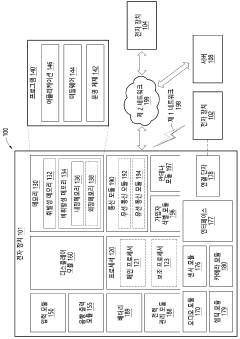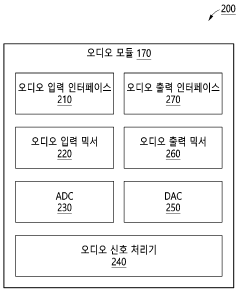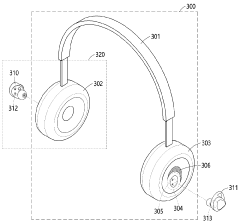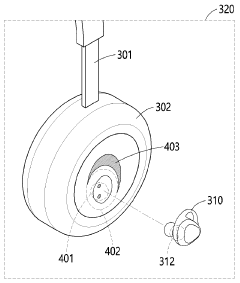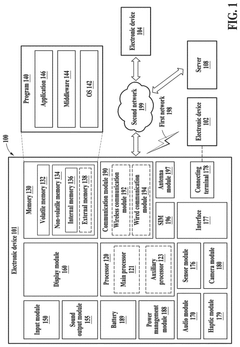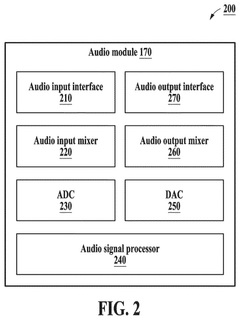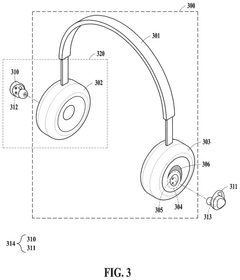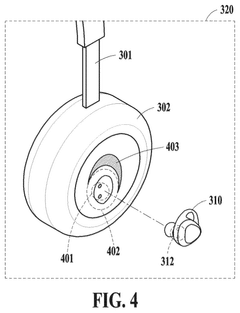How to Evaluate LDAC Compatibility in Headsets?
JUL 4, 20258 MIN READ
Generate Your Research Report Instantly with AI Agent
Patsnap Eureka helps you evaluate technical feasibility & market potential.
LDAC Technology Overview and Objectives
LDAC, developed by Sony in 2015, is a proprietary audio coding technology designed to deliver high-resolution audio over Bluetooth connections. This technology aims to overcome the limitations of traditional Bluetooth audio codecs by enabling the transmission of high-quality audio data at up to 990 kbps, significantly higher than the standard SBC codec used in most Bluetooth devices.
The primary objective of LDAC is to provide a near-lossless audio experience for wireless headphones and speakers, bridging the gap between wired and wireless audio quality. By utilizing advanced encoding algorithms and adaptive bit rate technology, LDAC can maintain optimal audio quality across various network conditions and device capabilities.
LDAC operates at three different bit rates: 330 kbps, 660 kbps, and 990 kbps. These options allow for flexibility in balancing audio quality with connection stability, depending on the environment and device specifications. The highest bit rate of 990 kbps is capable of transmitting 24-bit/96 kHz audio content, which is considered high-resolution audio.
The technology's evolution has been marked by its integration into the Android operating system since version 8.0 (Oreo), making it more accessible to a wider range of devices and manufacturers. This integration has significantly expanded the potential market for LDAC-compatible headsets and audio devices.
As the demand for high-quality wireless audio experiences continues to grow, LDAC has become an important differentiator in the headphone market. Manufacturers are increasingly adopting this technology to cater to audiophiles and discerning consumers who seek superior sound quality in wireless devices.
The development of LDAC is part of a broader trend in the audio industry towards improving wireless audio transmission. It competes with other high-quality Bluetooth codecs such as aptX HD and LHDC, each striving to provide the best possible audio experience over Bluetooth connections.
Understanding LDAC compatibility in headsets is crucial for both manufacturers and consumers. For manufacturers, it represents an opportunity to enhance their product offerings and appeal to a more demanding market segment. For consumers, LDAC compatibility can be a key factor in choosing a headset that delivers superior audio quality.
The primary objective of LDAC is to provide a near-lossless audio experience for wireless headphones and speakers, bridging the gap between wired and wireless audio quality. By utilizing advanced encoding algorithms and adaptive bit rate technology, LDAC can maintain optimal audio quality across various network conditions and device capabilities.
LDAC operates at three different bit rates: 330 kbps, 660 kbps, and 990 kbps. These options allow for flexibility in balancing audio quality with connection stability, depending on the environment and device specifications. The highest bit rate of 990 kbps is capable of transmitting 24-bit/96 kHz audio content, which is considered high-resolution audio.
The technology's evolution has been marked by its integration into the Android operating system since version 8.0 (Oreo), making it more accessible to a wider range of devices and manufacturers. This integration has significantly expanded the potential market for LDAC-compatible headsets and audio devices.
As the demand for high-quality wireless audio experiences continues to grow, LDAC has become an important differentiator in the headphone market. Manufacturers are increasingly adopting this technology to cater to audiophiles and discerning consumers who seek superior sound quality in wireless devices.
The development of LDAC is part of a broader trend in the audio industry towards improving wireless audio transmission. It competes with other high-quality Bluetooth codecs such as aptX HD and LHDC, each striving to provide the best possible audio experience over Bluetooth connections.
Understanding LDAC compatibility in headsets is crucial for both manufacturers and consumers. For manufacturers, it represents an opportunity to enhance their product offerings and appeal to a more demanding market segment. For consumers, LDAC compatibility can be a key factor in choosing a headset that delivers superior audio quality.
Market Demand for High-Quality Wireless Audio
The demand for high-quality wireless audio has been steadily increasing in recent years, driven by the growing popularity of mobile devices, streaming services, and the shift towards wireless audio solutions. Consumers are increasingly seeking immersive audio experiences that match or surpass the quality of wired connections, leading to a surge in interest for advanced audio codecs like LDAC.
The market for premium wireless headphones and earbuds has experienced significant growth, with consumers willing to invest in devices that offer superior sound quality. This trend is particularly evident in the rise of high-resolution audio streaming services, which cater to audiophiles and discerning listeners who demand lossless or near-lossless audio reproduction.
LDAC, developed by Sony, has emerged as a key technology in meeting this demand. It offers higher bitrates and better audio quality compared to standard Bluetooth codecs, making it attractive for consumers who prioritize audio fidelity in their wireless listening experience. The compatibility of headsets with LDAC has become a significant selling point, influencing purchasing decisions and brand preferences.
The professional audio sector has also shown increased interest in high-quality wireless audio solutions. Studios, content creators, and audio professionals are seeking wireless options that can maintain the integrity of their work without compromising on quality. This has led to a growing market for professional-grade wireless headphones and monitoring systems that support advanced codecs like LDAC.
In the gaming industry, there is a rising demand for wireless headsets that can deliver low-latency, high-fidelity audio. Gamers require precise audio cues and immersive soundscapes, driving the need for wireless solutions that can match the performance of wired gaming headsets. LDAC compatibility in gaming headsets is becoming a desirable feature for enthusiasts who want to maximize their audio experience.
The automotive sector represents another significant market for high-quality wireless audio. As vehicles become more connected and infotainment systems advance, there is a growing emphasis on delivering premium audio experiences to drivers and passengers. LDAC-compatible systems in cars are becoming a differentiating factor for luxury vehicle manufacturers, catering to audiophiles and enhancing the overall in-car entertainment experience.
As the Internet of Things (IoT) ecosystem expands, there is an increasing demand for high-quality wireless audio in smart home devices. From smart speakers to whole-home audio systems, consumers are looking for seamless, high-fidelity audio experiences that can be integrated into their connected living spaces. LDAC compatibility in these devices is becoming a key consideration for consumers who want to future-proof their smart home audio setups.
The market for premium wireless headphones and earbuds has experienced significant growth, with consumers willing to invest in devices that offer superior sound quality. This trend is particularly evident in the rise of high-resolution audio streaming services, which cater to audiophiles and discerning listeners who demand lossless or near-lossless audio reproduction.
LDAC, developed by Sony, has emerged as a key technology in meeting this demand. It offers higher bitrates and better audio quality compared to standard Bluetooth codecs, making it attractive for consumers who prioritize audio fidelity in their wireless listening experience. The compatibility of headsets with LDAC has become a significant selling point, influencing purchasing decisions and brand preferences.
The professional audio sector has also shown increased interest in high-quality wireless audio solutions. Studios, content creators, and audio professionals are seeking wireless options that can maintain the integrity of their work without compromising on quality. This has led to a growing market for professional-grade wireless headphones and monitoring systems that support advanced codecs like LDAC.
In the gaming industry, there is a rising demand for wireless headsets that can deliver low-latency, high-fidelity audio. Gamers require precise audio cues and immersive soundscapes, driving the need for wireless solutions that can match the performance of wired gaming headsets. LDAC compatibility in gaming headsets is becoming a desirable feature for enthusiasts who want to maximize their audio experience.
The automotive sector represents another significant market for high-quality wireless audio. As vehicles become more connected and infotainment systems advance, there is a growing emphasis on delivering premium audio experiences to drivers and passengers. LDAC-compatible systems in cars are becoming a differentiating factor for luxury vehicle manufacturers, catering to audiophiles and enhancing the overall in-car entertainment experience.
As the Internet of Things (IoT) ecosystem expands, there is an increasing demand for high-quality wireless audio in smart home devices. From smart speakers to whole-home audio systems, consumers are looking for seamless, high-fidelity audio experiences that can be integrated into their connected living spaces. LDAC compatibility in these devices is becoming a key consideration for consumers who want to future-proof their smart home audio setups.
LDAC Compatibility Challenges in Headsets
LDAC compatibility in headsets presents several significant challenges that require careful evaluation and consideration. One of the primary issues is the complex codec implementation required for LDAC support. Unlike simpler codecs, LDAC demands sophisticated hardware and software integration, which can be particularly challenging for smaller headset manufacturers with limited resources.
Another major hurdle is the power consumption associated with LDAC processing. The high-resolution audio transmission enabled by LDAC necessitates more intensive computational processes, potentially leading to increased battery drain. This is especially problematic for wireless headsets where battery life is a critical factor in user experience and product competitiveness.
Compatibility with various devices and operating systems also poses a significant challenge. While LDAC is widely supported on Android devices, its adoption on other platforms like iOS is limited. This fragmentation in the market can lead to inconsistent user experiences and complicate the development and testing processes for headset manufacturers.
The dynamic nature of LDAC's adaptive bitrate feature introduces additional complexity in ensuring consistent audio quality across different usage scenarios. Headsets must be capable of seamlessly adjusting to varying bitrates without compromising sound quality or introducing audible artifacts, which requires sophisticated signal processing capabilities.
Latency is another critical factor that needs careful evaluation. While LDAC offers high-quality audio transmission, it can introduce noticeable delay, particularly problematic for applications like gaming or video playback. Balancing audio quality with low latency becomes a delicate task for headset designers.
Furthermore, the licensing and certification process for LDAC technology can be a barrier for some manufacturers. Obtaining the necessary licenses and ensuring compliance with Sony's standards adds both cost and complexity to the development process.
Interoperability testing is also a significant challenge. Ensuring that LDAC-enabled headsets work seamlessly with a wide range of LDAC-compatible source devices requires extensive testing across multiple device types and software versions. This process can be time-consuming and resource-intensive, particularly for smaller manufacturers.
Lastly, the evolving nature of the LDAC codec itself presents ongoing challenges. As Sony continues to refine and update the technology, headset manufacturers must stay abreast of these changes and potentially update their products to maintain compatibility and optimal performance.
Another major hurdle is the power consumption associated with LDAC processing. The high-resolution audio transmission enabled by LDAC necessitates more intensive computational processes, potentially leading to increased battery drain. This is especially problematic for wireless headsets where battery life is a critical factor in user experience and product competitiveness.
Compatibility with various devices and operating systems also poses a significant challenge. While LDAC is widely supported on Android devices, its adoption on other platforms like iOS is limited. This fragmentation in the market can lead to inconsistent user experiences and complicate the development and testing processes for headset manufacturers.
The dynamic nature of LDAC's adaptive bitrate feature introduces additional complexity in ensuring consistent audio quality across different usage scenarios. Headsets must be capable of seamlessly adjusting to varying bitrates without compromising sound quality or introducing audible artifacts, which requires sophisticated signal processing capabilities.
Latency is another critical factor that needs careful evaluation. While LDAC offers high-quality audio transmission, it can introduce noticeable delay, particularly problematic for applications like gaming or video playback. Balancing audio quality with low latency becomes a delicate task for headset designers.
Furthermore, the licensing and certification process for LDAC technology can be a barrier for some manufacturers. Obtaining the necessary licenses and ensuring compliance with Sony's standards adds both cost and complexity to the development process.
Interoperability testing is also a significant challenge. Ensuring that LDAC-enabled headsets work seamlessly with a wide range of LDAC-compatible source devices requires extensive testing across multiple device types and software versions. This process can be time-consuming and resource-intensive, particularly for smaller manufacturers.
Lastly, the evolving nature of the LDAC codec itself presents ongoing challenges. As Sony continues to refine and update the technology, headset manufacturers must stay abreast of these changes and potentially update their products to maintain compatibility and optimal performance.
Current LDAC Compatibility Testing Methods
01 LDAC codec implementation in audio devices
LDAC is a high-quality audio codec developed for Bluetooth audio transmission. It can be implemented in various audio devices to enhance wireless audio quality. The codec supports different bit rates and sampling frequencies, allowing for flexible adaptation to different audio sources and transmission conditions.- LDAC codec implementation in audio devices: LDAC is a high-quality audio codec developed for Bluetooth audio transmission. It can be implemented in various audio devices to enhance wireless audio quality. The codec supports different transmission rates and can adapt to network conditions, providing a balance between sound quality and connection stability.
- Compatibility with existing Bluetooth protocols: LDAC is designed to be compatible with existing Bluetooth protocols, allowing it to work with a wide range of devices. This compatibility ensures that LDAC-enabled devices can communicate with non-LDAC devices, maintaining backward compatibility while offering improved audio quality when both devices support the codec.
- Integration of LDAC in software applications: Software applications can integrate LDAC codec support to enable high-quality audio streaming. This integration allows for seamless compatibility between devices and applications, ensuring that users can take full advantage of LDAC's capabilities across various platforms and services.
- LDAC in network communication systems: LDAC can be incorporated into network communication systems to improve audio quality in various applications. This integration can enhance voice and audio transmission in telecommunications, conferencing systems, and other network-based audio applications, providing clearer and more detailed sound.
- Compatibility testing and certification for LDAC: To ensure proper implementation and interoperability, devices and applications supporting LDAC may undergo compatibility testing and certification processes. These processes help verify that the LDAC codec is correctly implemented and functions as expected across different hardware and software configurations.
02 Compatibility with existing Bluetooth protocols
LDAC is designed to be compatible with existing Bluetooth protocols, allowing for seamless integration with a wide range of devices. This compatibility ensures that LDAC-enabled devices can communicate with non-LDAC devices, maintaining backward compatibility while offering enhanced audio quality when both devices support the codec.Expand Specific Solutions03 Software updates for LDAC support
Many devices can gain LDAC compatibility through software updates. This allows manufacturers to add LDAC support to existing products without requiring hardware changes. The update process typically involves firmware upgrades that enable the LDAC codec in the device's audio processing system.Expand Specific Solutions04 LDAC integration in audio streaming applications
Audio streaming applications can integrate LDAC support to provide high-quality audio playback on compatible devices. This integration involves implementing the LDAC codec in the application's audio processing pipeline and ensuring proper handshaking with LDAC-enabled Bluetooth receivers.Expand Specific Solutions05 Testing and certification for LDAC compatibility
To ensure proper LDAC implementation and compatibility, devices and applications may undergo testing and certification processes. These processes verify that the LDAC codec is correctly implemented and that the device or application meets the required performance standards for high-quality audio transmission.Expand Specific Solutions
Key Players in LDAC and Wireless Audio Industry
The evaluation of LDAC compatibility in headsets is currently in a growth phase, with the market expanding as more consumers seek high-quality wireless audio experiences. The technology's maturity is advancing, with key players like Sony (the developer of LDAC) and other major audio companies such as Bose, Samsung, and Huawei actively incorporating LDAC into their products. The market size is expected to grow significantly as LDAC becomes more widely adopted across various audio devices. Companies like Analog Devices and Cirrus Logic are likely contributing to the development of compatible chipsets, while tech giants like Google are integrating LDAC support into their mobile operating systems, further driving adoption and compatibility across the industry.
Bose Corp.
Technical Solution: Bose has developed a comprehensive LDAC compatibility evaluation system for their headsets. Their approach involves a multi-stage testing process that includes signal integrity analysis, audio quality assessment, and real-world performance validation. Bose utilizes specialized equipment to measure LDAC codec performance, including bit rate stability, frequency response, and dynamic range. They employ a combination of objective measurements and subjective listening tests to ensure optimal LDAC implementation[1]. Bose's evaluation process also includes compatibility testing with various LDAC-enabled source devices to guarantee seamless connectivity and performance across different platforms[3].
Strengths: Comprehensive testing methodology, industry-leading audio expertise. Weaknesses: Potentially time-consuming process, may require specialized equipment.
Huawei Technologies Co., Ltd.
Technical Solution: Huawei has developed an advanced LDAC compatibility evaluation system for their headsets, leveraging their expertise in both audio technology and mobile devices. Their approach incorporates automated testing suites that assess LDAC codec implementation, including bitrate adaptation, connection stability, and audio quality metrics. Huawei's evaluation process utilizes their HiSilicon chipsets to perform real-time analysis of LDAC performance, measuring factors such as transmission efficiency and power consumption[2]. They also employ machine learning algorithms to optimize LDAC compatibility across various usage scenarios and environmental conditions[4]. Huawei's system includes extensive interoperability testing with a wide range of LDAC-enabled devices to ensure broad compatibility.
Strengths: Integration of hardware and software testing, extensive device ecosystem for compatibility testing. Weaknesses: Potential bias towards own ecosystem, may not fully represent third-party device performance.
Core LDAC Technology and Implementation
Headphone device coupled to wireless earphones, operating method therefor, and wireless earphones
PatentWO2024043480A1
Innovation
- A headphone device and wireless earphones system is designed with LVDS conversion circuits and DACs to convert signals and power, allowing for efficient data transmission and power sharing between the units, enabling combined operation and improved audio output.
Headphone device coupled to wireless earphones, operating method therefor, and wireless earphones
PatentPendingUS20250184666A1
Innovation
- A headphone device comprising a headband with two headphone units, each connected to the headband and electrically connected to an earphone unit, which includes an LVDS conversion circuit, a DAC, and a speaker for audio output, as well as a cradle unit for coupling with the earphone unit.
Regulatory Standards for Wireless Audio Devices
Regulatory standards for wireless audio devices play a crucial role in ensuring the safety, performance, and interoperability of LDAC-compatible headsets. These standards are established by various international and regional organizations to maintain consistency and quality across the industry.
The Federal Communications Commission (FCC) in the United States sets regulations for wireless devices, including Bluetooth headsets. FCC Part 15 governs radio frequency devices and requires manufacturers to comply with specific emission limits and operational parameters. For LDAC-compatible headsets, adherence to these regulations is essential to prevent interference with other wireless devices and ensure proper functioning within the allocated frequency bands.
In the European Union, the Radio Equipment Directive (RED) 2014/53/EU establishes a regulatory framework for placing radio equipment on the market. This directive covers various aspects, including safety, electromagnetic compatibility, and efficient use of the radio spectrum. LDAC-compatible headsets must comply with these standards to be legally sold and used within the EU market.
The International Electrotechnical Commission (IEC) develops global standards for electrical and electronic technologies. IEC 62368-1 is particularly relevant for audio/video equipment, including wireless headsets. This standard focuses on safety requirements and aims to protect users from potential hazards associated with the use of these devices.
Bluetooth Special Interest Group (SIG) certification is another crucial aspect of regulatory compliance for LDAC-compatible headsets. The Bluetooth SIG oversees the development of Bluetooth standards and ensures interoperability between devices. Manufacturers must obtain Bluetooth certification to use the technology and associated trademarks legally.
In addition to these general standards, specific regulations may apply to LDAC technology. As LDAC is a proprietary audio codec developed by Sony, manufacturers implementing this technology must adhere to Sony's licensing requirements and technical specifications. This ensures that LDAC-compatible headsets meet the necessary quality and performance standards set by the codec's creators.
When evaluating LDAC compatibility in headsets, it is essential to consider these regulatory standards and certifications. Manufacturers must demonstrate compliance with relevant regulations through testing and documentation. This may include submitting devices for laboratory testing, obtaining necessary certifications, and providing detailed technical specifications to regulatory bodies.
Consumers and industry professionals should look for appropriate certification marks and compliance statements when assessing LDAC-compatible headsets. These indicators provide assurance that the device meets the required regulatory standards and is safe for use in the intended markets.
The Federal Communications Commission (FCC) in the United States sets regulations for wireless devices, including Bluetooth headsets. FCC Part 15 governs radio frequency devices and requires manufacturers to comply with specific emission limits and operational parameters. For LDAC-compatible headsets, adherence to these regulations is essential to prevent interference with other wireless devices and ensure proper functioning within the allocated frequency bands.
In the European Union, the Radio Equipment Directive (RED) 2014/53/EU establishes a regulatory framework for placing radio equipment on the market. This directive covers various aspects, including safety, electromagnetic compatibility, and efficient use of the radio spectrum. LDAC-compatible headsets must comply with these standards to be legally sold and used within the EU market.
The International Electrotechnical Commission (IEC) develops global standards for electrical and electronic technologies. IEC 62368-1 is particularly relevant for audio/video equipment, including wireless headsets. This standard focuses on safety requirements and aims to protect users from potential hazards associated with the use of these devices.
Bluetooth Special Interest Group (SIG) certification is another crucial aspect of regulatory compliance for LDAC-compatible headsets. The Bluetooth SIG oversees the development of Bluetooth standards and ensures interoperability between devices. Manufacturers must obtain Bluetooth certification to use the technology and associated trademarks legally.
In addition to these general standards, specific regulations may apply to LDAC technology. As LDAC is a proprietary audio codec developed by Sony, manufacturers implementing this technology must adhere to Sony's licensing requirements and technical specifications. This ensures that LDAC-compatible headsets meet the necessary quality and performance standards set by the codec's creators.
When evaluating LDAC compatibility in headsets, it is essential to consider these regulatory standards and certifications. Manufacturers must demonstrate compliance with relevant regulations through testing and documentation. This may include submitting devices for laboratory testing, obtaining necessary certifications, and providing detailed technical specifications to regulatory bodies.
Consumers and industry professionals should look for appropriate certification marks and compliance statements when assessing LDAC-compatible headsets. These indicators provide assurance that the device meets the required regulatory standards and is safe for use in the intended markets.
User Experience and LDAC Performance Metrics
Evaluating LDAC compatibility in headsets requires a comprehensive assessment of both user experience and technical performance metrics. The user experience aspect focuses on the perceived audio quality, ease of connection, and overall satisfaction with the LDAC-enabled device. This can be measured through subjective listening tests, where users rate the audio clarity, soundstage, and detail reproduction across various music genres and audio content types.
To quantify the user experience, standardized questionnaires and rating scales can be employed, allowing for consistent comparison across different headset models. These assessments should include factors such as comfort during extended listening sessions, battery life impact when LDAC is enabled, and the stability of the wireless connection in various environments.
On the technical side, LDAC performance metrics provide objective data to support the subjective evaluations. Key metrics include the actual bitrate achieved during playback, which can vary depending on the connection quality and device capabilities. LDAC supports multiple bitrate modes (330 kbps, 660 kbps, and 990 kbps), and the ability of a headset to maintain the highest bitrate consistently is a crucial indicator of its LDAC compatibility.
Latency is another critical metric, particularly for applications requiring precise audio-video synchronization. Measurements should be taken to determine the end-to-end latency introduced by LDAC encoding and decoding processes. Additionally, the frequency response and dynamic range of the headset when operating in LDAC mode should be analyzed to ensure that the full potential of the high-resolution audio codec is realized.
Signal-to-noise ratio (SNR) and total harmonic distortion (THD) measurements can provide insights into the headset's ability to reproduce clean, undistorted audio when using LDAC. These metrics should be compared against the headset's performance with other codecs to highlight the benefits of LDAC implementation.
To ensure comprehensive evaluation, testing should be conducted across various devices and operating systems that support LDAC. This cross-platform assessment helps identify any compatibility issues or performance variations that may arise due to differences in hardware or software implementations.
Ultimately, the evaluation of LDAC compatibility in headsets should aim to correlate the technical performance metrics with the user experience data. This holistic approach provides a complete picture of how well a headset leverages LDAC technology to deliver high-quality audio to the end-user, balancing the technical capabilities with real-world usability and satisfaction.
To quantify the user experience, standardized questionnaires and rating scales can be employed, allowing for consistent comparison across different headset models. These assessments should include factors such as comfort during extended listening sessions, battery life impact when LDAC is enabled, and the stability of the wireless connection in various environments.
On the technical side, LDAC performance metrics provide objective data to support the subjective evaluations. Key metrics include the actual bitrate achieved during playback, which can vary depending on the connection quality and device capabilities. LDAC supports multiple bitrate modes (330 kbps, 660 kbps, and 990 kbps), and the ability of a headset to maintain the highest bitrate consistently is a crucial indicator of its LDAC compatibility.
Latency is another critical metric, particularly for applications requiring precise audio-video synchronization. Measurements should be taken to determine the end-to-end latency introduced by LDAC encoding and decoding processes. Additionally, the frequency response and dynamic range of the headset when operating in LDAC mode should be analyzed to ensure that the full potential of the high-resolution audio codec is realized.
Signal-to-noise ratio (SNR) and total harmonic distortion (THD) measurements can provide insights into the headset's ability to reproduce clean, undistorted audio when using LDAC. These metrics should be compared against the headset's performance with other codecs to highlight the benefits of LDAC implementation.
To ensure comprehensive evaluation, testing should be conducted across various devices and operating systems that support LDAC. This cross-platform assessment helps identify any compatibility issues or performance variations that may arise due to differences in hardware or software implementations.
Ultimately, the evaluation of LDAC compatibility in headsets should aim to correlate the technical performance metrics with the user experience data. This holistic approach provides a complete picture of how well a headset leverages LDAC technology to deliver high-quality audio to the end-user, balancing the technical capabilities with real-world usability and satisfaction.
Unlock deeper insights with Patsnap Eureka Quick Research — get a full tech report to explore trends and direct your research. Try now!
Generate Your Research Report Instantly with AI Agent
Supercharge your innovation with Patsnap Eureka AI Agent Platform!
